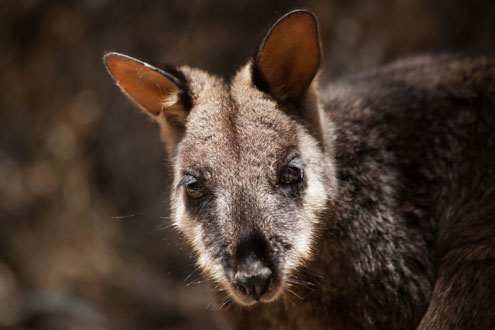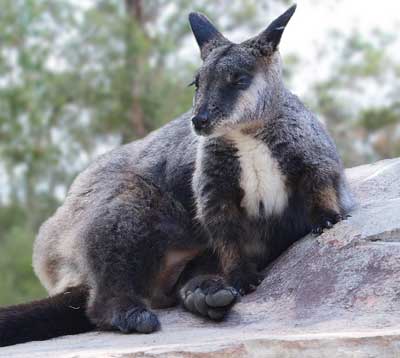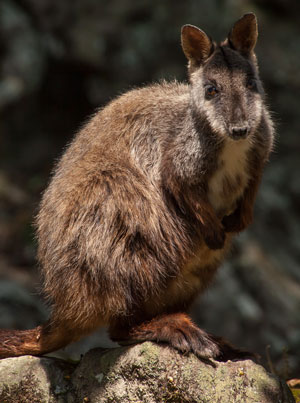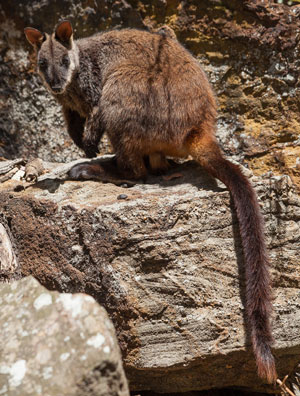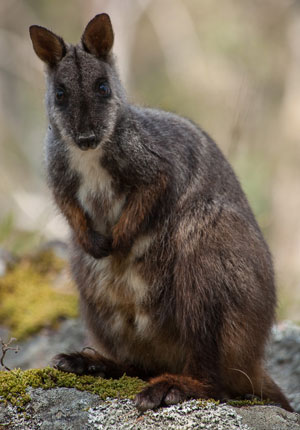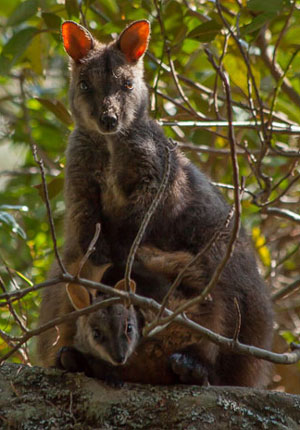Two Brush-tailed Rock-wallaby articles -
- Brush-tailed Rock-wallaby (Petrogale penicillata) by Judy Smith
- Moments with wallabies by Ian Brown
Brush-tailed Rock-wallaby (Petrogale penicillata) by Judy Smith
The relatively short hind feet have much reduced claws but the soles of the feet are equipped with outstandingly large granulated pads.
It is as if this wallaby is born wearing a pair of volley sandshoes, ready to scale the cliffs and steep rocky areas it inhabits.
This wallaby forms small colonies and typically shelters by day in overhangs on north-facing cliffs and rocky slopes, moving out in the afternoon and evening to feed in nearby grassy areas.
In the late 1800s it lived along the Nepean River.At Jenolan Caves, Sid Bellingham, a local hunting guide, noted in 1899 that the Brush-tailed Rock-wallaby was “at one time plentiful”, “the Grand Arch and other outside caves were simply the camping place of rock wallabies” and “afforded good lively shooting”, but the species was declining by the late 1800s.
The Brush-tailed Rock-wallaby has suffered widespread population declines and extinctions and is now considered to be endangered in NSW and vulnerable at national level.
In the Greater Blue Mountains World Heritage Area (GBMWHA) it is now a rare resident at the western edge of its current known range, it formerly extended into inland NSW.
A stronghold for the species is northern Wollemi and Yengo National Parks, where there is suitable habitat across the escarpment of the southern Hunter Valley.
Other recent locations in the GBMWHA include north of Faulconbridge Point Lookout in Blue Mountains National Park, the Wollondilly River catchment in Nattai National Park and, as a result of careful management by the NSW National Parks and Wildlife Service, it still frequents the Jenolan area, including the main tourist precinct.Possibly it persists in Kanangra-Boyd National Park, where it was last sighted near Church Creek Caves in 1989.
In the early 1870s Brush-tailed Rock-wallabies were introduced to New Zealand from Australia and have since prospered, to the point of becoming a local pest.
Recent molecular genetic studies indicate that these ‘kiwi’ animals most likely originated from a population at Winmalee (probably from within what is now Blue Mountains National Park).
Given the sorry state of the Brush-tailed Rock-wallaby around Winmalee today, the naturalized New Zealand population represents a potentially valuable conservation resource for Australia.
The above article first appeared in the Blue Mountains Conservation Society newsletter, Hut News, June 2018.
Moments with wallabies by Ian Brown
At first he was unconcerned, but then suddenly jumped and was gone, ricocheting like a rubber ball from side to side up the vertical walls of a narrow chasm in the cliff.
I was left gaping at the astounding dexterity of an animal so attuned to its habitat.
No wonder he was so relaxed; he must have made those difficult moves so many times before that he could repeat them perfectly and easily escape any intruder.
Some of the rock surfaces where rock wallabies live are polished like enamel.
I’ve seen other rock wallaby species on Cape York Peninsula, in central Australia and in the Flinders Ranges, but the first Brush-tailed Rock-wallaby I ever saw was on the Mann River, now part of Nymboida National Park in northern NSW. It bounded away across a maze of granite boulders…leaving me amazed at the size of its feet! ‘Macropod’ of course means ‘large foot’ but these seemed out of all proportion compared to other wallabies and kangaroos. They certainly have a ‘good hold on Australia’ – but as individuals, not as a species.Brush-tailed Rock-wallabies were once common and widespread across the Greater Blue Mountains, but have been driven to the edge of extinction; first by hunting and then by introduced predators.
They now survive in small numbers scattered through the broken sandstone country of the northern Blue Mountains, with particular concentrations in the safest habitat (there is also a small managed population at Jenolan Caves).
The rubber ball I saw was in a remote part of Wollemi National Park.
For the past 20 years the National Parks & Wildlife Service (NPWS) has been monitoring some of these preferred sites in the Wolgan and Capertee gorges; places that combine massive cliff-falls, with towers and boulder piles, and patches of viney rainforest.They count scats in the same places twice a year, and use camera traps to spot wallabies, predators and other animals.
The population monitoring has been coupled with intensive baiting of foxes and wild dogs.
These ‘core’ colonies are doing well with protection.
The eight monitoring sites have reasonably stable populations with an estimated minimum of 220 individuals in total (there was a downward blip at one site, since recovered, when it was burnt by wildfire in 2003).
The hope is that the sites are supporting as many wallabies as they can, and that population increase is dispersing to nearby areas.
As a rockclimber and bushwalker, I feel an affinity with these marvellous, charismatic creatures and how they so perfectly inhabit their rocky terrain.
I used to think I was a pretty good (human) rock-hopper until I saw them. I’ve been fortunate to help on some of the Wollemi monitoring, and have enjoyed many encounters with rock wallabies.
Several of us were hiding there, as she preened without concern and then hopped quietly away.
Another time we saw a female with a joey peering out of her pouch, which was so uplifting.
Such memories are cherished.

